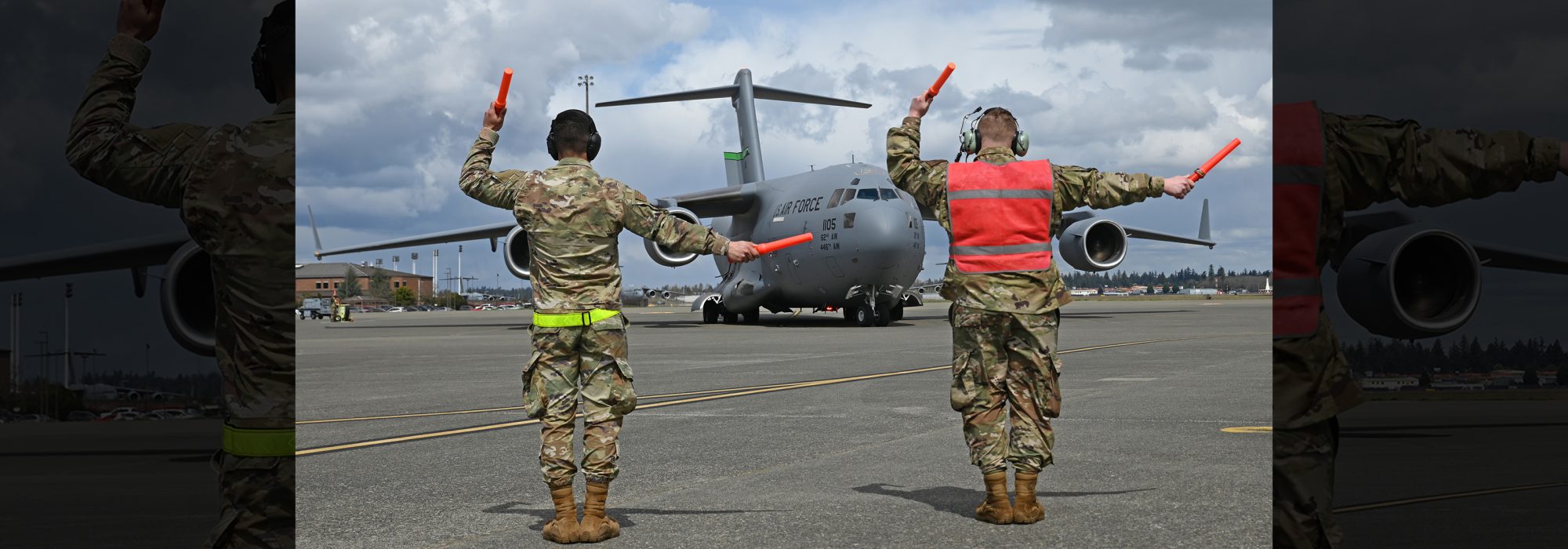Resilient Basing
For decades, the U.S. Air Force has operated mainly from large forward operating bases, reflecting the calculation that the risk of conflict with a peer adversary largely disappeared with the demise of the Soviet Union. In the Middle East, regional foes lacked the ability to hold such bases under aerial threat. Elsewhere, the Department of Defense consolidated bases in the name of economic efficiency.
Now all those assumptions are turned on their head. China and Russia now see denying the U.S. military the ability to operate from its large forward operating bases in a crisis as the first step in blocking the U.S. during conflict, limiting its ability to project power. Both Iran’s and North Korea’s growing missile programs pose similar risks. Indeed, Tehran demonstrated its ability to threaten bases in January 2020, when it fired nearly a dozen missiles at U.S. forces at Al Asad Air Base in Iraq.
CHALLENGE: We must deny our adversaries an easy targeting opportunity and the perceived vulnerability that a small number of known fixed locations provides.


APPROACH: A mix of investments in resilient forward basing for current and planned tactical aircraft. The concept that the Department of the Air Force is pursuing in this regard, called Agile Combat Employment (ACE), is a strong step in the right direction, but a range and combination of concepts must be considered and resourced.
“The general impression over the past few decades that U.S. air bases were somehow sanctuaries was a historical anomaly,” noted a January 2023 RAND report.
The Air Force has 33 permanent overseas bases, all locations well known to potential adversaries. Significantly, many of the Pacific bases are well within the range of Chinese missiles.
“The threat has grown qualitatively and quantitatively,” said Stacie Pettyjohn of the Center for a New American Security.
The Pentagon’s latest report card on China’s People’s Liberation Army provides a similar assessment. “The PRC’s military modernization efforts have rapidly transformed the PLA’s missile force,” it states. “PLA writings frame logistics and power projection assets as potential vulnerabilities in modern warfare, which aligns with the PLA’s expanding ability to conduct strikes against regional air bases, logistics and port facilities, communications, and other ground-based infrastructure.”
In response, the Air Force has made “Resilient Basing” a top priority. What that means is less about new technology and weapons and more about augmenting USAF’s ability to repair runways, harden facilities against missile and cyber attack, and operate in the face of electronic jamming. The deployment of additional missile defense systems is also important, though base defense remains largely an Army mission.
The Air Force is also pursuing a new way of war. At the direction of Air Force Secretary Frank Kendall and Air Force Chief of Staff Gen. Charles Q. Brown Jr., Agile Combat Employment or ACE has become a fundamental operating concept.
ACE reduces reliance on large central bases in favor of a flexible hub-and-spoke system, in which the service can rapidly disperse forces to spartan locations, complicating an adversary’s targeting and defensive schemes. By taking advantage of airpower’s flexibility, USAF would carry out a new twist on an island-hopping campaign in the Pacific.
The basic precepts of the Air Force plan have been endorsed by outgoing Chairman of the Joint Chiefs of Staff Army Gen. Mark A. Milley. The fundamental character of warfare “is actually changing in really significant and radical ways,” he said at a June 30 National Press Club event. “The battlefield of the future will require rapid and constant movement and the ability to remain small and relatively invisible just to survive,” he said. “If you’re dead, you’re not going to be any contribution to fighting the war.”
Carrying out ACE, however, is easier said than done. ACE demands a more distributed system of command and control, as well as major logistical shifts, such as prepositioning parts, equipment, and fuel at some potential bases in anticipation of future use.
“Additional work is being done to identify and create capabilities and formalized training programs to field an agile force that sets the theater and establishes distributed command and control,“ the service said in its posture statement to the House Armed Services Committee.
“Logistics has always been a great strength of American airpower, and we will not let it become a weakness,” said Lt. Gen. Tom Miller, deputy chief of staff for logistics, engineering, and force protection, after table-top exercises at MacDill Air Force Base, Fla., put numerous new concepts to the test, including how to supply forces across vast distances in the western Pacific.
Changes to individual training are also in the works. The Air Force aims to rely on Multi-Capable Airmen, skilled beyond their specialties, to do an increasing variety of work.
In May, Airmen skilled in administrative and other non-engineering work traveled from Mountain Home Air Force Base, Idaho, to Dobbins Air Reserve Base, Ga., for a crash course in runway repair. Going from classroom to cutting concrete in three days, finance, personnel, medics, and others learned to repair simulated craters from missile strikes, according to the Air Force.
“The reason we’re doing Multi-Capable Airmen is that we may be back in a combat situation where we have a lot of casualties,” Kendall said during an event at the Center for a New American Security in June.
Other services changing operational concepts will also demand changes from the Air Force. For example, the Marine Corps’ new force design calls for small groups of Marines to be dispersed throughout islands in the western Pacific where, they would be equipped with anti-ship missiles to bottle up the Chinese fleet. The Army is likewise developing new models for the region.
“There’s certain things that are common to all of us: fuel, water, food, munitions—things that we could all use,” Brown said at a June 7 event at the Mitchell Institute for Aerospace Studies. “That’s going to drive some logistics challenges that I think we need to work through as a joint force.”
U.S. Transportation Command, under Air Force Gen. Jacqueline Van Ovost, is already working on how to ensure the U.S. military can be properly supplied.
“We need to make sure we can assuredly move that fuel and get it to where it needs to go,” Van Ovost said June 6 during a Brookings Institution event when asked about supporting concepts such as ACE. “We also need to relook where our fuel posture is to meet the requirements.”
The Air Force operates a vast air refueling fleet that operates under TRANSCOM as part of Air Mobility Command. But the vast majority of U.S. military fuel is transported by sea, a capability that has been neglected over the years
Another critical step is top-level diplomacy to secure the basing options and defense cooperation that the Air Force and other services require.
President Joe Biden hosted the leaders of Japan, South Korea, India, and the Philippines this year, as leaders of all four countries made official state visits to Washington, D.C., during the first half of 2023.
That diplomacy has yielded expanded access to operating bases in the Philippines, increased bomber presence in Korea, new drone sales to India, and F-16 sales to the Philippines. Japan is buying hundreds of land-attack cruise missiles from the U.S.
The U.S. is also building on its already tight relations with Australia to help Canberra acquire its own nuclear-powered submarines and to collaborate on unmanned aircraft and command and control operations. That would lead to increased Air Force deployments, adding another potential hub in the ACE spoke. Australia is planning a major upgrade to B-52 facilities at Royal Australian Air Force Base Tindal in the Northern Territory, which could see it become an important staging base for American strategic bomber and other large aircraft.
The administration has also pledged $7.1 billion in its 2024 budget to the Marshall Islands, Micronesia, and Palau to renew compacts with those countries that give the U.S. military basing options.
“There’s a strategic calculation on the part of the Biden administration to build up our allies,” said Patrick Cronin, an Asia-Security expert at the Hudson Institute.
Some experts say new approaches to basing, while helpful, are not enough, in and of themselves, to counter the Chinese and that a more fundamental shift in Air Force thinking is called for.
“There’s no silver bullet,” said David Ochmanek of the RAND Corporation, a former deputy assistant secretary of defense for force development and a former Air Force officer.
Ochmanek said the Air Force needs to embrace the concept of mass, such as thousands of small unmanned systems, which could be set aloft from mobile launchers on the ground, as well as palletized munitions.
“I really think the big indicator of a cultural change in the Air Force will be when they unambiguously embrace runway independence,” he said. “As the Chinese deploy more and more ballistic and cruise missiles, all of which are very accurate, it’s not possible, at least with currently available active defense systems, to comprehensively protect any single base or group of bases against large salvos.”
In its proposed fiscal 2024 budget, the Air Force plans to invest $1.2 billion in resilient basing. New funding “represents a maturation of ACE concepts,” according to Air Force spokeswoman Ann Stefanek, to “start of long-term projects, such as infrastructure improvements of nontraditional airfields, pre- positioning assets, and agile communications.”
A vital step will be putting the ACE concept into practice on regularly, so the Air Force can demonstrate its aircraft would not be sitting ducks in a crisis, but could rapidly disperse into a warfighting posture and, thus, strengthen deterrence, Pettyjohn said.
It’s time, she said, for the Air Force to move beyond preaching ACE to “routinely practicing it so you know that you can do it.”
